
What Makes Franz Liszt Still Important?
This week sees the 200th anniversary of the birth of Franz Liszt. Leon Botstein, President of Bard College and music director and principal conductor of the American Symphony Orchestra, explores what we can still learn from the life and music of Liszt.
October 17, 2011
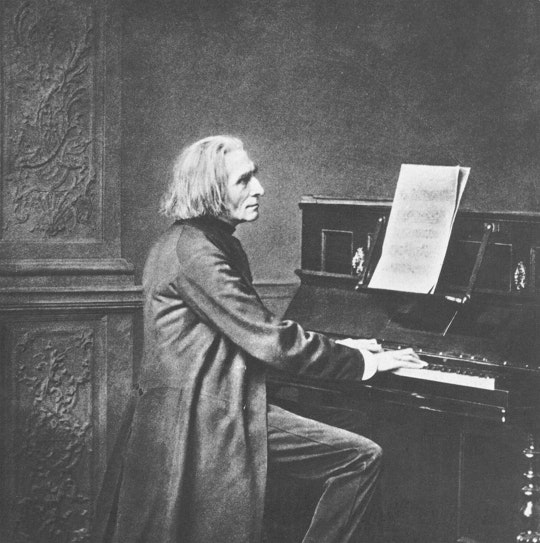 Scroll through the whole page to download all images before printing.
Scroll through the whole page to download all images before printing.Marking anniversaries of the birth and death of historic figures, particularly in music, is somewhat akin to commemorating annually the date of death of family members. It is never quite clear whether we are struggling to remember those to whom we were once close as we pursue our lives without them, all in an effort to assuage the guilt that comes with the natural tendency to forget, or whether we are indulging in a form of nostalgia, shaped in part by using the selective memory of the past to make claims about what our present and future lives ought to be but have seemingly little chance of becoming. And as we commemorate we rarely penetrate beneath the surface of received opinion, revising a set of inherited judgments.
In our concert life these anniversaries become easy excuses to justify a comfortable and unexamined account of what history has bequeathed as “great” music. Marking the 100th or 200th anniversary rarely leads to a change in the concert repertory. We belabor the obvious. One might consider the Gustav Mahler centenary in 1960 as an exception since it took place at the beginning of a Mahler revival. But the two-year extended Mahler remembrances that are justified by the 100th anniversary of his death (2011) and the 150th of his birth (2010) have functioned to ossify a sentimental historical portrait and further enshrine the central place Mahler’s music has in the orchestral repertory.
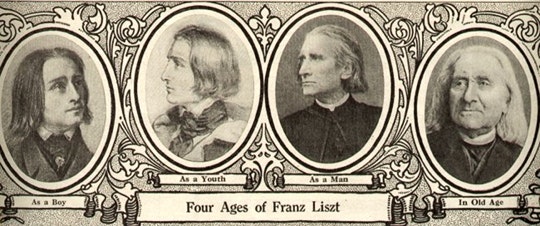 Scroll through the whole page to download all images before printing.
Scroll through the whole page to download all images before printing.The Four ages of Franz Liszt, as published in The Etude magazine, 1913.
The case of Franz Liszt, who was born in 1811 and died in 1886, is more complex. Celebrating the 200th anniversary of his birth ought to have been an opportunity to revisit a figure who helped define Romanticism, the role of the piano on the stage and in the home, and, most importantly, how music functions for most of the literate public. Yet our attention to him remains largely muted and ambivalent. Only a few of his works are still in the standard orchestral repertory — the piano concertos and one tone poem Les Preludes. Pianists bring out a few select works in recital, mostly to display the virtuosity they demand. This is in stark contrast to Chopin, his contemporary, whom Liszt championed. The choral and organ music are never performed. If one compares this to Liszt’s output, not only for the piano, (which is gargantuan in scope), one cannot help but be struck by the obscurity that most of his music has fallen into. The last effort in a major city to revive Liszt’s music took place in New York in the 1970s under the leadership of Pierre Boulez.
If we choose to remember Liszt more than in passing, it is as the legendary and charismatic personality he was, with all its complexities — his notorious love life, his turn to religion, his relationship with Richard Wagner and Wagner’s second wife, Liszt’s daughter Cosima. There never has been a better subject in music history for a Hollywood movie. He was classical music’s most successful, colorful, and long-lived superstar; he acquired and retained more groupies than any one before or since.
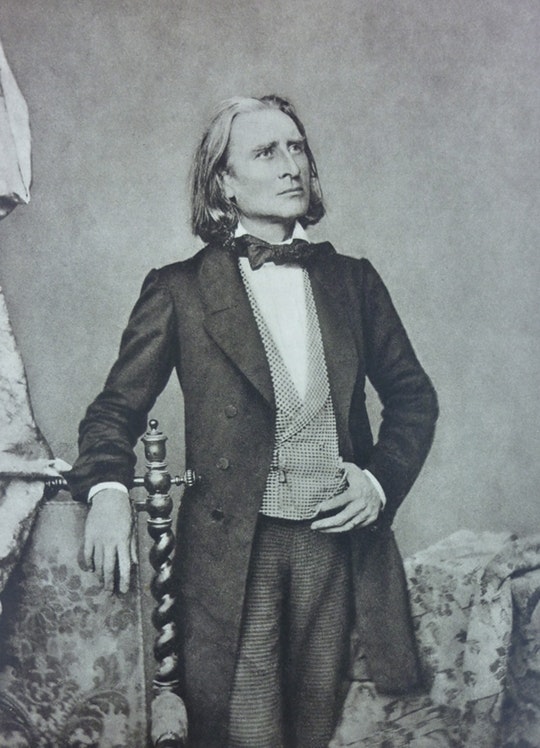 Scroll through the whole page to download all images before printing.
Scroll through the whole page to download all images before printing.Photograph of Franz Liszt taken in 1858, featured in Die berühmten Musiker by Lacroix Jean, Kunstverlag by Lucien Mazenod, 1946.
We may also choose to recall that he was likely the greatest and most facile pianist that ever lived and perhaps the most influential teacher of the instrument. Liszt’s pupils and their pupils dominated the musical landscape for generations. He defined the personality of the concert pianist, even though, ironically, Liszt gave up concertizing relatively early in his career. Perhaps we also acknowledge Liszt’s uncommon generosity to and support for his contemporary composers, from Chopin and Wagner to Grieg and Saint-Saëns, as well as his influence on a younger generation, including Mahler, Richard Strauss, and Jean Sibelius.
As the bicentenary comes to a close without much ado, what have we missed? What indeed might we still learn and profit from taking a deeper and more comprehensive look at Liszt and his career?
First, Liszt ought to remind us that our approach to music should not be dependent on some construct of nationality that helps prop up the popularity of a composer. Reputations in classical music after Beethoven seem increasingly dependent on nationalist enthusiasms. We seek Hungarians to perform Bartók, Russians Tchaikovsky, the English Elgar, the French Debussy, and Americans Copland and Ives. Liszt defies this easy categorization. He was at one and the same time crucial to what we now regard as quintessentially Hungarian, German, and French. His reach as an artist and composer transcended national categories and reminds us of the limitations of nationalist appropriations and stereotypes.
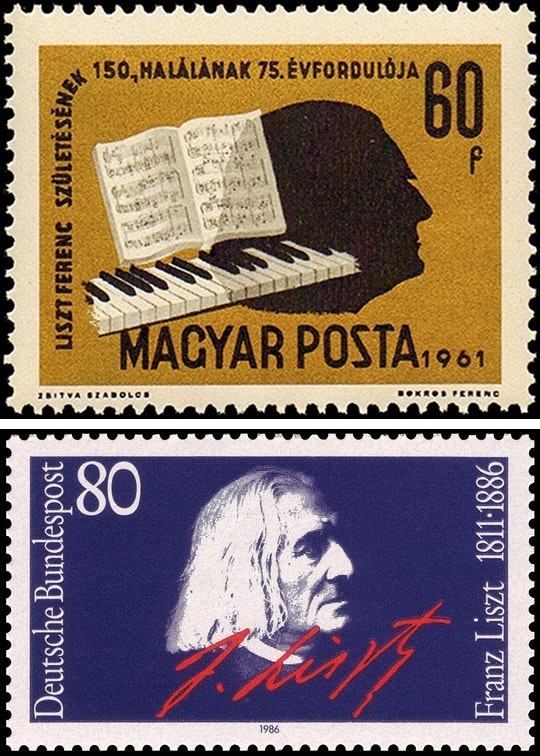 Scroll through the whole page to download all images before printing.
Scroll through the whole page to download all images before printing.Top: Hungarian Stamp from 1961 celebrating 150th anniversary of Liszt’s birth. Bottom: German stamp from 1996 celebrating the 100th anniversary of his death.
Second, Liszt’s art bridged all genres. At the heart of his music for the piano was improvisation, an art sadly lost in what we now term classical music. Few, if any classical musicians can do it. Notation in his piano music sought to mirror an art that was spontaneous and tied to a moment of performance. His elaborations and fantasies for the piano based on the operatic works of others suggest many ways of freely adapting and altering music we like and wish to remember. The same can said for his transcriptions of works by Bach and Beethoven, where music written for one medium is translated into another. Liszt’s piano versions of the Beethoven symphonies (Beethoven was a composer Liszt venerated and spent a lifetime advocating) were particular favorites of that brilliant eccentric, Glenn Gould. We musicians would be well served by following Liszt’s example by liberating ourselves from some delusive ideology of faithfulness to historic texts, adapting old and new music into the framework of our own new music, and altering it to reach a generation of listeners accustomed to new sounds and a novel acoustic environment. Liszt did that using the piano, and by so doing he helped create an enthusiastic audience of spectators.
Third, Liszt pioneered in rendering music an art form connected to literature, painting, and narration. His notion that instrumental music can and should evoke character, landscape, plot, emotion, and ideas (for example in his tone poem Die Ideale, based on Schiller) laid the groundwork for what we now take for granted as the musical semantics and rhetoric we encounter in music for film and television. The magic in Liszt was that just music alone sufficed to spur the audience’s imagination. Playing Liszt and listening to his work reminds us of the power of music to tell and augment a story and evoke and embellish a memory. This is particularly the case with respect to the connection between spirituality and religion and music, as Liszt’s late orchestral work From the Cradle to the Grave and his massive oratorio Christus make clear.
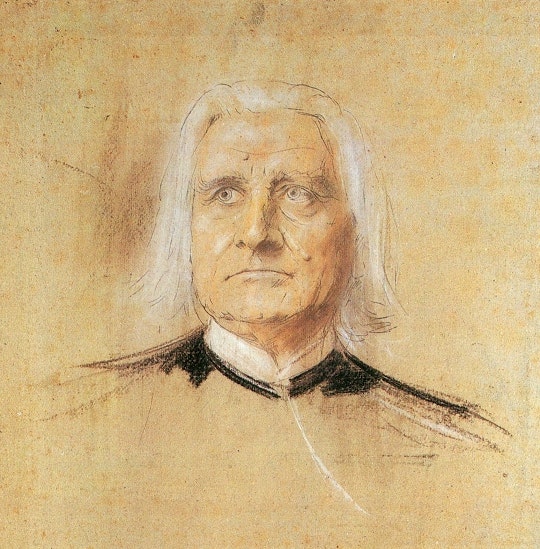 Scroll through the whole page to download all images before printing.
Scroll through the whole page to download all images before printing.Pastel impression of Liszt by the German artist Franz von Lenbach (1836–1904), ca. 1880, currently at the Städtische Galerie im Lenbachhaus, Munich.
Fourth, Liszt was a tireless innovator, never content to repeat himself. Without Liszt’s experiments in the uses of harmony and sonority and the shape of musical form (for example, the stress on single melodies and motives and therefore imaginative repetition in works of considerable duration) much of late Romanticism and Modernism, particularly that associated with Wagner, would be unthinkable. He harbored few prejudices and was, to the end of his days, receptive to the work of younger composers and enthusiastic about new ideas — as his generous treatment of Russian composers amply suggests. We live in too segmented an environment, where the classical and the popular are still segregated, except for occasional all too facile efforts at so-called crossover works and events. Originality was just one of the goals Liszt pursued. He borrowed happily from others and sought to integrate diverse influences into a synthetic and syncretic expressive musical art form. That expansive tendency helped lend him early on in his career as a composer the ill deserved reputation of being all too facile and superficial.
Fifth, consistent with his adherence to improvisation and transcription, he defined interpretation as a creative act, even when performing a Beethoven sonata, as close to a “sacred” text as exists in the 19th-century piano literature. He added and subtracted, inserted transitions, and refashioned the meaning of historic masterpieces. Perhaps the best known is his adaptation of Schubert’s Wanderer Fantasy into a work for piano and orchestra.
A more protean, gifted, generous, and versatile figure in music’s history can hardly be imagined, one who sought to keep the past alive and to link tradition with the contemporary. From Liszt we can learn that mere imitation and endless repetition of the same will not do and will condemn an art form to a form of living death. Virtuoso par excellence that he was, he despised mere athleticism in music — the single-minded obsession with speed, accuracy, circuslike tricks, and above all, arbitrary affectation in the rendering of music, attributes that have come to define our contemporary concert life. He demanded that performance and composition be kept together and define the performing musician. And yet he reveled in the theater of performance, with lightness and irony.
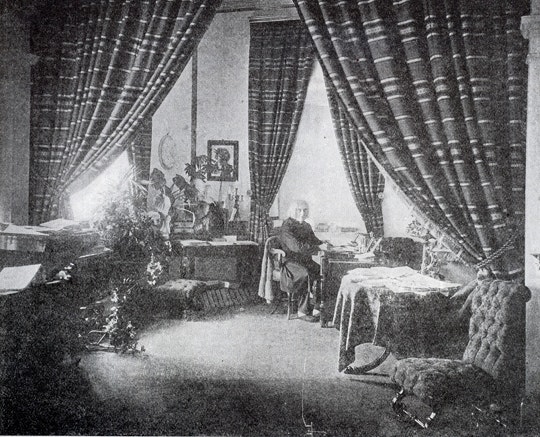 Scroll through the whole page to download all images before printing.
Scroll through the whole page to download all images before printing.Photograph of Liszt in his music room in Weimar in 1884 — published in Modern Music and Musicians, University Society, New York, 1918
However, in order to gain the full measure of Liszt’s achievement and to benefit from his example far more of his music needs to be heard on the concert stage. Two great symphonic works, the Dante and Faust symphonies—although they have made periodic comebacks—need to be a regular part of the repertory. The same applies to the many orchestral tone poems, from Orpheus to Tasso. And the great choral music (the Missa solennis and the 13th Psalm, for example) should return to active life and take their place alongside the Mozart Requiem and Handel’s Messiah. Last but not least, there is the endless treasure trove of piano music well beyond the Transcendental Etudes.
Liszt was the first composer-performer to find ways, as a pianist and conductor, to reach a wide public, to make music accessible and enjoyable to more than a self-styled elite of connoisseurs. He did so by connecting music to the public’s wider interests, in poetry and prose, in politics, in history, and in art and religion. He wrote on music, including a biography of Chopin. He ran a court theater in Weimar where he gave the first performances of Wagner’s Lohengrin and Schumann’s Genoveva. He laid the foundations of Hungary’s modern musical life by founding Budapest’s conservatory. He used his fame and artistry on behalf of political and humanitarian causes.
What we can and must learn from Liszt is precisely what it means to be a musician, and to be, as a musician, at the center of a community’s political and cultural life, and to do so fearlessly, courageously, and generously. He set an example of what it requires to be, truly, a citizen of the world as a composer and performer, as one who broke rules and conventions to chart new paths. That was the message contained in Arnold Schoenberg’s 1911 centenary appreciation of Liszt. The very same exhortation needs repeating a century later. The difference is that in 1911 Liszt the composer had become largely derided. Today he is no longer controversial, just neglected.
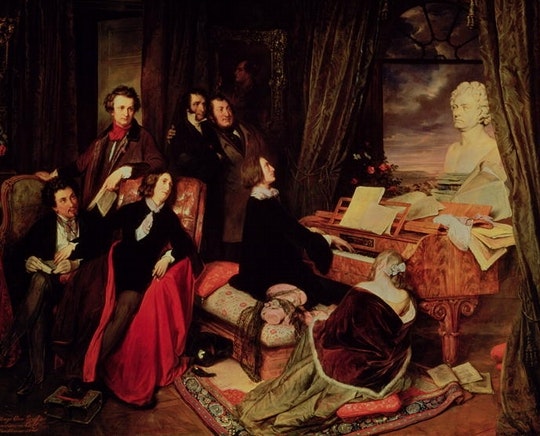 Scroll through the whole page to download all images before printing.
Scroll through the whole page to download all images before printing.Franz Liszt Fantasising at the Piano (1840) by Josef Danhauser — depicting Liszt playing in a Parisian salon on a grand piano made by Conrad Graf, who commissioned the painting; on the piano is a bust of Ludwig van Beethoven by Anton Dietrich; the imagined gathering shows seated Alexandre Dumas, George Sand, Franz Liszt, Marie d’Agoult; standing Hector Berlioz or Victor Hugo, Niccolò Paganini, Gioachino Rossini; and a portrait of Byron on the wall.
Leon Botstein is music director and principal conductor of the American Symphony Orchestra and conductor laureate of the Jerusalem Symphony Orchestra. He is founder and coartistic director of the Bard Music Festival, which celebrates its 22nd season this year at Bard College, the institution he has served as president since 1975. He is the editor of The Musical Quarterly and the author of many articles and books. For his contributions to music he has received the Award for Distinguished Service to the Arts from the American Academy of Arts and Letters, the Centennial Medal of the Harvard Graduate School of Arts and Sciences, and the Austrian Cross of Honour for Science and Art. He is a recipient of the Carnegie Foundation’s Academic Leadership Award and a member of the American Philosophical Society.







